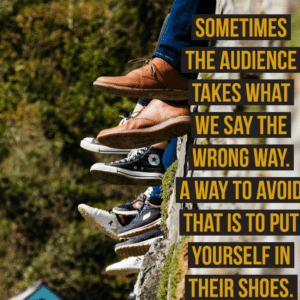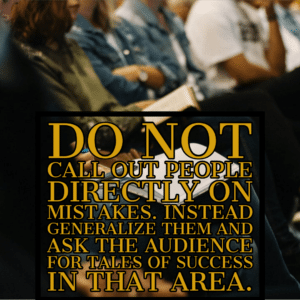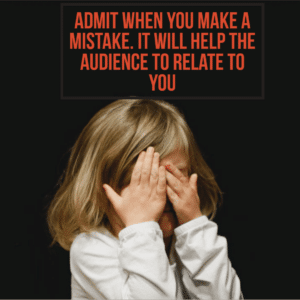
Eventually, if you present often, you will be required to deliver content that the audience either isn’t in agreement with or, about which, your audience will be argumentative. It takes a skilled presenter to be able to deliver content like this in a way that doesn’t create a conflict with the audience. We are continuing our series on Improving Communication Skills, and this week, we will cover a few ideas that will help you avoid disagreement and resolve conflicts. Before I cover these tips, however, keep in mind that if you follow the guidelines that we teach in our blogs, podcasts, and in our classes, you will be able to design presentations that are “audience focused.” These types of presentations are less likely to create conflicts with your audience. So, if you find that you have to create a presentation that you know your audience is going to disagree with, be sure to go through some of our earlier sessions like How to Design a Presentation and Making Your Presentation Title Audience Focused.
This is part four of our series on Improving Communication Skills. In part one, we talked about how a great communication coach can help you improve your communication skills more quickly. Next, we showed you a few simple things that you can do to shut down a heckler or someone who is peppering you with negative questions. In part three, we gave a number of ways to build trust and rapport with your audience. In the final sessions, we will show you how to use your words to gain enthusiastic cooperation from your audience.
Part 4: A Few Simple Ways to Avoid Conflicts when Presenting Your Ideas to Groups.
The first few tips are designed to avoid conflicts before they are actually created. The last few are designed to help us resolve conflicts and diffuse situations when the audience begins to fight you.
Be Proactive Versus Reactive.
When you design your speech, make sure to put yourself in the shoes of the audience and anticipate how they will react to your presentation. Sometimes, we may think that we are being clear and easily understood, but the audience just takes what we say the wrong way.
For instance, let’s say you are a sales manager and sales have dropped significantly. If you were to present just the fact, without any editorial at all, to your sales team, there will still be a likely chance that the team will perceive the presentation as being critical of their work. They may believe you are blaming them, even if you didn’t intend to create this impression. So, in this case, you might want to temper your deliver a little. A little forethought can help keep some conflicts from ever being created.
Be Slow to Anger (Be Slow to Extreme Emotion.)
Anger is one of the strongest emotions, but really, just about any extreme emotion from a presenter can be seen by the group as being negative. I tend to find that when I’m upset about something, and I go on stage, the audience will often react in kind. When someone is angry at us or is showing anger to us, human nature is that we often respond to the person at an even higher level.
If you talk to really good customer service reps in big companies, they will tell you that no one is logical when they are angry. So, it is better to let the person vent his or her frustration a little before responding. In the episode on Dealing with Presentation Hecklers, one of the tips was to ask a clarifying question. This technique allows you to pause and keep from retaliating. However, it also allows the person to vent a little. In fact, just like the customer service rep, as the person talks, the speaker can dig a little deeper by asking the person to include more details. The more the person vents, the less angry he/she will feel. Now, we have a better chance of winning over the person with logic.
One final thing, I mentioned above that any extreme emotion can cause a challenge. In some cases, we can be interrupted with a challenging question and instead of feeling anger back, we feel nervousness or even panic. If you show this extreme emotion to your audience, it will be like blood in the water. You will have a difficult time recovering. Just take a few breaths, ask your clarifying question, and then think about what you want to say. You don’t have to respond right away. Sometimes, a dramatic pause can help you clarify your thoughts and respond in a more poised way.
Point Out Mistakes of Others Indirectly
Remember that when we are speaking from a position of authority, if we call out others for their mistakes in front of a group, we can be seen by the group as being argumentative or petty. The old adage is that when you point a finger at someone else, you will have three of your other fingers pointing at you. So, if we have to point out mistakes that people in the group (or the entire group) has made, we want to do this indirectly. For instance, if we as a group have failed, and I’m the leader, I may have to take responsibility for that challenge. By the way, this happens a lot when I teach presentation classes.
Another way to do this is with audience participation. If only a few people in the audience are making the mistake and most of the group is doing really well, I might ask the audience to relay some of their successes to the entire group. Instead of saying, “Some of us in this room really suck at _______,” an alternative might be, “I know that _______ can sometimes be challenging, but I know a few of you in here have been able to really excel in this area. Could I get a few of you to give us a few tips on some simple things that you have done to make this process much easier?” So, instead of being critical to a few members of the group, we can easily switch to making the people doing the right thing the heroes.
Look for Common Ground.
When you find that you are in a conflict with your audience, look for some type of common ground as soon as possible. Even the bitterest of enemies can agree n something. Once you find just a single point of agreement, you can build on that agreement. A good example of this is politics.
One of the things that good legal mediators do is get both parties in separate rooms, and each will have a legal pad. The mediator will ask each to just brainstorm each and everything that he/she wants to gain from the dispute, no matter how trivial. Then, the mediator takes both lists and looks for anything at all that is on both lists. Once a single item is found, it “breaks the ice.” You can do the same with your audience. Look for anything at all that you believe that both you and they agree with. Start with that item.
If You are Wrong Admit It.
This is one of the more difficult tips, but it is also one of the more important ones. Sometimes you will find that you or your company has genuinely made a mistake. When you discover this, it is critical that you confess to that mistake. Most people (most companies) will take great effort to cover up their mistakes or lay blame elsewhere. Many a lawsuit have been filed because the person who was truly in the wrong refused to admit it. This is especially important if you are the leader of the group.
Admit One of Your Own Poor Decisions Before Pointing Out a Similar Error of Others.
I saved this one for last, because I find it to be the most useful as a presenter or speaker.
For additional details, see Persuasive Speech Outlines.
Resolving Conflicts is Not the Most Fun Type of Presentation, But It Can Be an Opportunity.
When you have to create and deliver one of these challenging presentations, you’ll see that they are not as much fun as other presentations. However, they can be very rewarding. They can also be fantastic ways to grow members of your team in a positive way. Next week, we will give you some ways to gain enthusiastic cooperation from your audience. (These types of presentations are WAY more fun!)

